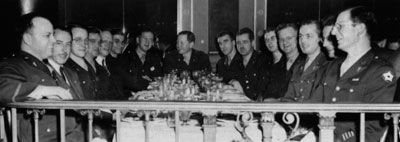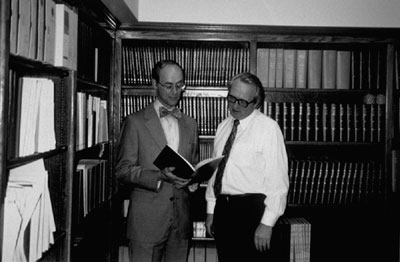Creation of ASSH has roots in the treatment of injuries during war
Sterling Bunnell, MD, founded the American Society for Surgery of the Hand in 1946.
As swarms of injured soldiers returned from World War II with complex hand injuries, a need arose for a specialized society that could organize and educate surgeons in hand surgery, according to Daniel J. Nagle, MD, current president of the American Society for Surgery of the Hand.
Before World War II, care for hand injuries was fragmented, as neurosurgeons, generalists, orthopedists and plastic surgeons all participated in operations on the hand. This fragmented care led to a special interest in the hand as a distinct entity. This meant that one surgeon could care for all of the hand tissues: nerves, tendons, vessels, skin and bones, David Tate, MD, FACS, current head of the history committee of the American Society for Surgery of the Hand (ASSH), told Orthopedics Today.
General surgeon Sterling Bunnell, MD, was a pioneer of hand surgery and trained surgeons in the subspecialty in San Francisco, according to Nagle. In 1944, U.S. Army Surgeon General Norman T. Kirk asked Bunnell to lead the establishment of nine hand surgery centers in the United States. Bunnell traveled to each center, teaching and performing hand surgeries, Nagle said. These centers became the basis for the formation of ASSH.
The founders
In 1916, a forerunner of Bunnell, Allen B. Kanavel, MD, who served in the Naval Reserves, “got the ball rolling with rational anatomically-based comprehensive hand care,” Tate said. Kanavel published the first book on hand surgery, Infections of the Hand, and started the Chicago School of Hand Surgery.
|
Images: American Society for Surgery of the Hand. |
“Dr. Bunnell took it to the next level in terms of a standardized mode of care that encompassed all these different disciplines,” Tate said.
Bunnell’s 1944 book, Surgery of the Hand, became the standard hand surgery text at the time, according to Tate.
“Bunnell had suffered a hip fracture in 1927 during the crash of a small airplane,” Tate said. “In spite of this non-united hip fracture, Bunnell displayed great energy and drive, traveling around the country on a private airplane helping coordinate care for all the injured soldiers and sailors [at the different centers].”
Bunnell and colleague, Joseph Boyes, MD, wanted to sustain communication between all of the hand centers through a professional society, according to Nagle and Tate. This desire led to the mission of ASSH, which is “to offer a forum to perpetuate the camaraderie and support an exchange of ideas between the hand surgeons who had manned the hand surgery services in the nine Army general hospitals,” Nagle said.
Bunnell, Boyes and a group of other interested surgeons from the nine centers met at the Blackstone Hotel in Chicago on January 20, 1946 to discuss this mission. What emerged was the first hand surgery society.
Membership expands
At first, obtaining membership to ASSH was exclusive. Perspective ASSH members had to submit a lecture and have it accepted by a committee to be a part of the association. There were 35 members at the start, Tate said.
In the early 1970s, the society began discussing the definition of hand surgery and making membership more inclusive. This resulted in the dramatic increase in the growth of membership of the society.
|
|
In the early 1980s, because of the increased sophistication of hand surgery, an effort was made to create of the Certificate of Added Qualifications in Surgery of the Hand (CAQSH). Its inception and creation, largely by the efforts of past ASSH president George E. Omer, MD, resulted in the first examination of the CAQSH given in 1989.
To become an active member of ASSH, members must now complete their residency in orthopedics, general surgery or plastic surgery, do a hand surgery fellowship, obtain their specialty board certification, go into practice, pass the CAQSH and submit a case list, application and letters of recommendation to ASSH. Today there are 1,866 active ASSH members, and the group has a total membership of 3,223.
Hand surgery advances
Before World War II, hand injuries often resulted in stiff, unusable hands, amputations or even death if the hand became infected, said Tate.
There was no replantation or microsurgery, according to Robert Szabo, MD, MPH, president of ASSH from 2009 to 2010. He recalled meeting a patient of Bunnell at “a little bed and breakfast in Napa Valley.” Bunnell performed Dupuytren’s surgery on the patient.
“Bunnell did all surgeries standing up without any magnification and big knives,” Szabo noted. “He used a 22 blade as opposed to now; the biggest blade is a 15.”
Szabo said the patient told him, “Look, he did a great job. He only cut one of my nerves.” Szabo added that at the time, if a surgeon cut just one nerve in Dupuytren’s surgery, “you did okay.”
“Hand surgery has changed dramatically,” Andrew Weiland, MD, ASSH president from 1995 to 1996, said. “In 1975, there was a birth of microsurgery where we were able to sew back traumatically amputated fingers and limbs. There have been tremendous advances in the repair of nerve injuries and in different types of fixation devices, plates and screws, for fractures of the hand and wrist.”
Focus on education
The society’s mission continues to be the education of its members, according to Szabo. Annual meetings are a forum for hand surgeons to meet and present their scientific findings. Nagle also noted that the mission of the society also includes the education of its members regarding the business aspects of hand surgery and advocacy in regards to changes in the health care environment.
“Research is also one of its core missions,” he said.
|
|
ASSH held its first meeting in 1947 at the Palmer House in Chicago, according to Nagle. The Palmer House continued to remain the place for ASSH members to meet and share innovative hand surgery studies until the 16th meeting was held in Florida.
Until the 1970s, Nagle said, ASSH members published their studies in the Journal of Bone and Joint Surgery. Eventually, the publication ran out of space to accommodate the large influx of hand surgery papers. Adrian Flatt, MD, president of ASSH from 1975 to 1976, founded the Journal of Hand Surgery, with Boyes as its first editor.
Between 1974 and 1978, the Hand Society Council formed committees to evaluate postgraduate educational training because there were no formal hand surgery training programs, Szabo said.
ASSH helped develop hand surgery fellowships. George E. Omer, MD, head of the Continuing Education Committee, developed quality controls for fellowship, according to Szabo. ASSH used to make onsite reviews for accreditation; however accreditation is now obtained through the Accreditation Council for Graduate Medical Education.
The American Foundation for Surgery of the Hand, the fundraising arm of ASSH formed 25 years ago, provides public patient information, funds for fellows to attend meeting, financial backing for innovative research and fellowships for young residents, according to Weiland, the foundation’s committee chairman. He estimated the endowment at about $7 million.
Collaborative efforts
Collaboration exists not only between ASSH members, but also between ASSH and other societies. ASSH participates in many of the American Academy of Orthopaedic Surgeons advocacy activities and joint education projects, Nagle said. ASSH also works with the American Society for Plastic Surgery, the American College of Surgeons, the American Medical Association and the American Association for Hand Surgery.
ASSH also fosters education among nations, Szabo said. ASSH combines meetings with international societies each year such as the Japanese or British hand surgery societies. ASSH also accepts members from other countries. The only fellowship officially sanctioned by ASSH, the Sterling Bunnell fellowship, allows a young member of the society to “travel around the world to observe how hand surgery is being performed in various offshore hand surgery centers,” Nagle said.
Future goals
Because the definition of hand surgery continues to evolve and now includes upper extremity surgery, ASSH foresaw the need to increase training “to match the scope of what our practices are and to redefine our identity,” Szabo said. He has created a new education initiative to move toward 2-year fellowships, which would add an extra year of training to existing fellowships and include upper extremity education. This move is a work in progress, Szabo said, who hopes to see its inception by 2012.
Other goals of the society include task forces to focus on hand replantation and increased member involvement, such as using social media to engage members, and developing an online archive of historical material and apps for smart phones. Each president has their own platform for the future, Szabo said, noting the platform for upcoming president W.P. Andrew Lee, MD, will address membership benefits. Edward Akelman, MD, slated for presidency after Lee, is concerned about electronic advancement of the society, Szabo noted.
“We must continue to maintain ASSH’s position as the premier provider of hand surgery education,” Nagle said. – by Renee Blisard
- Daniel J. Nagle, MD, can be reached at Northwestern University Feinberg School of Medicine, 737 N. Michigan Ave., Suite 700, Chicago, IL 60611; 312-337-6960; email: scruz@chicagohandsurgery.com.
- Robert Szabo, MD, MPH, can be reach at Department of Orthopaedic Surgery, University of California, Davis, 4860 Y Street, Sacramento, CA 95817; 916-734-3678; email: rmszabo@ucdavis.edu.
- David Tate, MD, FACS, can be reached at Louisville Arm and Hand, 315 E. Broadway, Suite 195, Louisville, KY 40202; 502-629-4263; email: hce1939@yahoo.com.
- Andrew Weiland, MD, can be reached at 535 E. 70th St., New York, NY 10021; 212-606-1575; email: weilanda@hss.edu.



